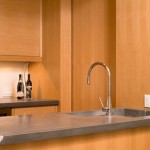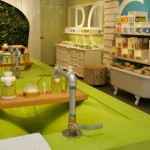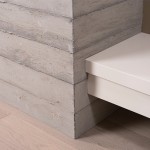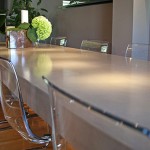Why Concrete?
Versatility. Concrete has seemingly limitless design capabilities; if you can dream it, chances are we can make it. No curve is too sharp and no design is too complex. The resurgence in popularity for the material is no surprise; concrete endures the test of time gracefully. The applications are endless and the results are stunning.
What is Concrete?
Concrete and cement are often confused. Concrete is made up of mainly sand, cement, and aggregate (various loose particulate materials, such as crushed stone, slag, gravel, pebbles, etc). Since sand and aggregate do not bond to each other cement is added as a binding agent, you can think of it as the glue. Concrete draws upon some of the earth’s most common and plentiful minerals for its raw materials. For example, the predominant raw material in cement is limestone, the most abundant mineral on earth which is readily available.
Concrete is an extremely durable material, if properly cared for a concrete piece can outlive its owner. Virtually unaffected by heat and cold, UV rays and moisture, concrete’s durability goes a long way towards waste reduction. The longevity of concrete means less maintenance and replacement when compared to other building materials.
How is the 2Stone concrete different from traditional concrete?
Our mix design consists of high strength glass fibre embedded in a cementations matrix. This type of concrete can outlasts traditional concrete, cultured stone, and even some natural stones.
Typical problems associated with traditional precast concrete and how our mix differs-
Cracking– this is usually caused by using too much water. While some manufacturers may use in excess of a 50% water/cement ratio, we keep ours at 30%. This yields a stronger, denser product. The cement only requires a certain amount of water to fully hydrate and going beyond that will only weaken the cement paste. This excess water will remain in the concrete for some time as it slowly works its way out. This excess moisture is one of the common causes for cracking. As it goes into winter months with the residual moisture, it causes a lot of stress internally as the water freezes and thaws. Calgary has very harsh conditions in this category with our Chinooks where we can have hundreds of freeze thaw cycles in one day. Thus, keeping a low water cement ratio is a key part of creating a durable exterior product.
Spalling– which is when the concrete breaks off into chips or fragments, is often caused by the rusting of the steel reinforcement. We do NOT use steel reinforcement, only glass fibre. Our glass fibre is alkaline resistant so that it does not break down in the cement matrix. Spalling is also caused by the expansion of large aggregate just beneath the surface, which we do NOT use, there is no large aggregate in our mix.
Efflorescence– efflorescence can occur in natural and built environments. On porous construction materials it may present a cosmetic problem. This is a white residue (salts) that is left behind after the transmission of moisture. We use what is called a pozzolan cement blend. Pozzolans are a key ingredient in making high performance concrete. A pozzolan is an ingredient that exhibits cement like qualities, but with many added advantages. One of the principal reasons of increased durability is the lowered calcium hydroxide content available to cause efflorescence and salt attack.
In addition to this, the pozzolan replaces up to 25% of our cement greatly reducing our energy consumption. Is a certified 100% post-industrial recycled product. It is smaller than the cement particles, thus greatly increasing the concrete’s density while also giving the concrete greater resistance to acids. Improved surface detail, color, and longevity.
Please contact us with any inquiries, we would be please to provide you with information and pricing on any of our standard or custom products.
What level of care and maintenance is required with 2Stone products?
A topical sealer or coating is a covering that is applied to the surface of the concrete. They are applied (topical sealer/coating) to improve the surface properties of the concrete such as appearance, wettability, acid resistance, wear resistance, and scratch resistance.
Our veneers will be delivered unsealed, depending on the application and location you may choose to seal your veneers. Please be aware that some sealers will enhance the color while others will not, there is also different sheens to be aware of. Always perform a test on a small section to ensure the results you want. If you do choose to seal them yourself please follow the care and maintenance guidelines provided by the sealer manufacturer.
If your product has been delivered to you sealed (most of our furniture, countertops, vanities, etc) please follow the following care and maintenance guidelines. The best care you can give your concrete is preventative care
If you are unsure if your 2Stone product has been sealed or not please contact us.
What should I use to clean it?
When cleaning your concrete always think simple. Use only plain soap or mild dish soap, a terry towel and warm water. Natural non-abrasive cleaners are also an option; however most “green” products contain vinegar which can be harmful to the concrete’s sealer so make sure to read the ingredients before trying out a new product. Stay clear from cleaners like Ajax, Windex, Formula 409, and Simple Green.
What to avoid.
All of the pieces that leave the 2Stone studio are treated with a sealant making the concrete water and stain resistant. However, stain resistant does not mean stain proof. The sealer is meant to give you time to remove a potential staining agent from the surface. When caring for you piece watch out for acids such as red wine, vinegar, perfume, hair products, and lemon juice which can etch the surface of your piece if left for an extended period of time. Clean up all spills. For the objects you plan to have on your piece permanently like coffee machines and soap pumps/dishes, we recommend placing foot pads underneath it. This will prevent it from causing scratches/scuffing overtime as well as allow air to pass underneath so if there is a spill left behind it will be able to dry up. Do not scratch or cut the coating as it will leave the concrete underneath vulnerable to staining. Do not place hot items (such as pots or curling irons) directly on the concrete as it could compromise the sealer.
What can I do to help maintain the finish?
Routine upkeep will result in a long life for your piece.
Repairs/refinishing can be done at an hourly rate. If you have any further questions please don’t hesitate to contact us.






